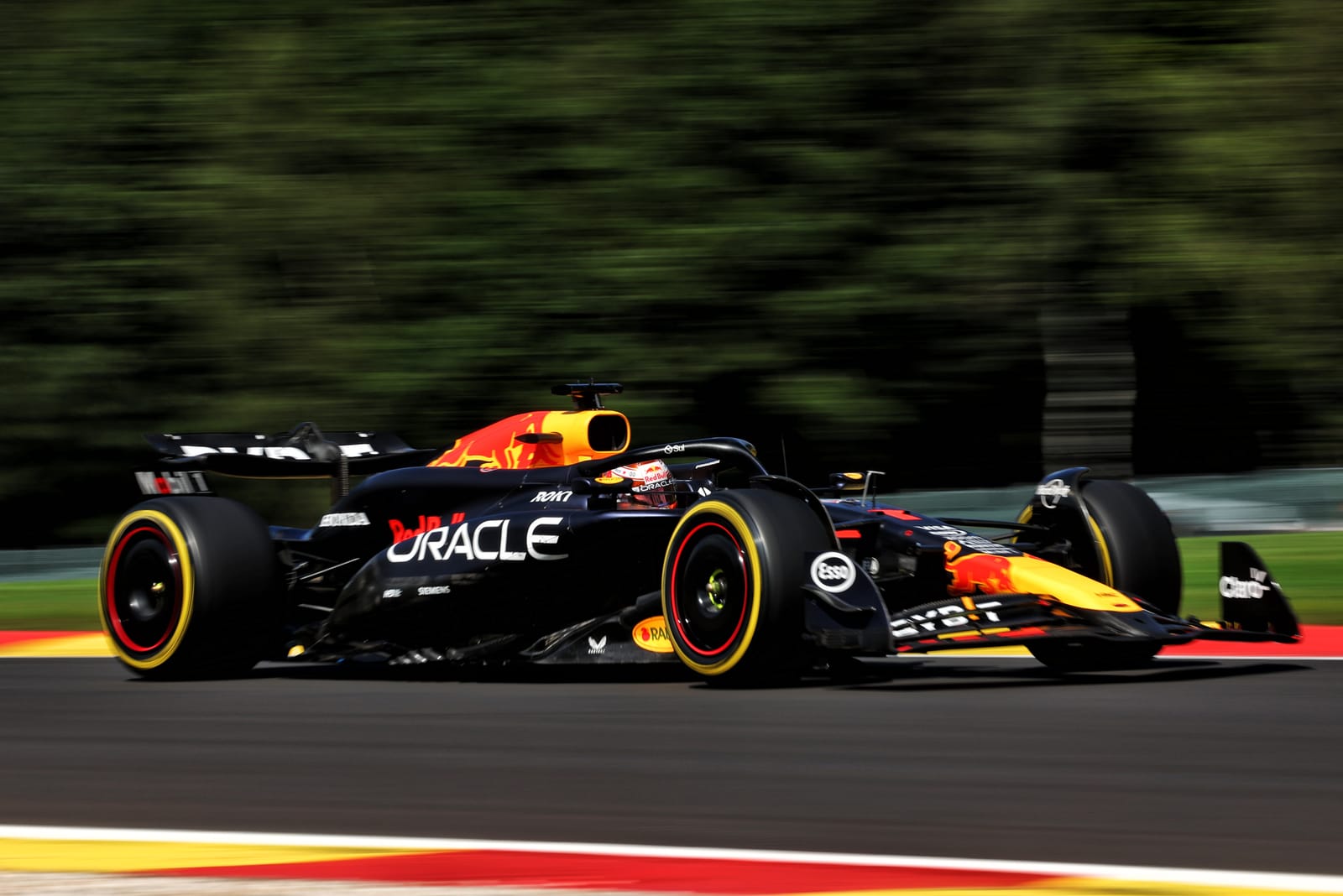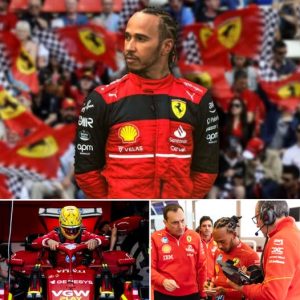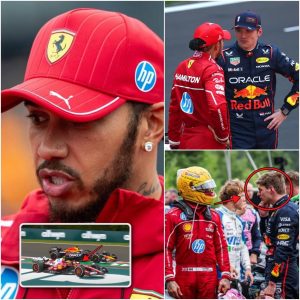With 14 race weekends complete and Formula 1 heading into its well-earned August break, the season’s shape is becoming clear. Rather than simply ranking teams by championship position, we’re judging them against realistic pre-season expectations — and assigning each a school-style grade from A to F, with pluses and minuses for nuance.
The aim is to measure not only outright results, but how well each team has maximised its package, handled setbacks, and developed over the campaign so far.
Red Bull — Grade: D
Solid execution trackside, but falling far short of title-contender standards.
By the standards of most teams, two wins and a sprint victory would be a strong showing. But Red Bull is no ordinary team — it has dominated the current rules era, and anything less than a championship fight is a disappointment.
Max Verstappen has been the team’s saviour, delivering against-the-odds victories at Suzuka, Imola, and in Saturday’s Spa sprint. However, persistent balance limitations have plagued the RB21, particularly mid-corner, and baffling grip issues at the Hungaroring underlined the inconsistency.
Upheaval off-track, notably the shock departure of team principal Christian Horner, hasn’t helped. The result: Verstappen is 97 points adrift of championship leader Oscar Piastri, and the team is nowhere near mounting a serious title push. Upgrades introduced in Belgium have shown promise, but the deficit is too big.

Sauber — Grade: B+
Tangible progress and a strong step forward ahead of the Audi transition.
Sauber’s pre-season was chaotic, with a narrow mechanical window and a nervous-handling car. But from the first race in Australia, new-spec components — front wing, sidepods, and floor — improved its competitiveness. The big leap came with the Spanish GP floor upgrade, which transformed the car’s drivability and consistency.
Subsequent developments at the Red Bull Ring and Silverstone have built on that foundation, making Sauber a regular points-scorer. Nico Hülkenberg’s podium in a wet Silverstone race was the highlight, and while the C45 still isn’t the easiest car to drive, it’s now a credible midfield weapon.
Ferrari — Grade: D
Winless when a title challenge was expected.
After narrowly missing out on the 2024 constructors’ crown, Ferrari entered 2025 with high hopes. Yet it has managed only five podiums and one sprint win (Lewis Hamilton in China). Major car changes — including a rearward-shifted cockpit and shortened gearbox to open up aero opportunities — haven’t delivered.
The tightly packaged central rear damper proved underpowered, forcing higher-than-intended ride heights and costing downforce. Even with upgrades at Spa improving Charles Leclerc’s confidence on the limit, the SF-25 still fades in races it qualifies well in. Hamilton’s adaptation struggles have compounded the pain. A season of unmet expectations.

Alpine — Grade: F
Simply not good enough.
From promising pre-season pace to rock-bottom reality, Alpine’s 2025 has been a disaster. The major culprit is the power unit’s weak energy recovery, which forces setup compromises and undermines race pace. While the chassis is decent in fast corners, it’s erratic overall, with poor traction and bump compliance.
Pierre Gasly has scored all of Alpine’s points, while the second seat — occupied first by Jack Doohan, then Franco Colapinto — has yielded nothing. The abrupt departure of team principal Otmar Szafnauer’s successor Ollie Oakes only adds to the turmoil.

Racing Bulls — Grade: B-
Decent car, under-delivering on results.
On paper, Racing Bulls has arguably led the midfield more than anyone this year, with a benign, confidence-inspiring car. However, points haven’t flowed as they should, due in part to an early driver swap (Yuki Tsunoda for Liam Lawson) and strategic missteps in Australia and China.
A diffuser tweak in Belgium showed progress, and when the stars align — as in Austria, where Lawson finished sixth — the RB01 can be best of the rest. But race-weekend execution must improve to match the car’s potential.
Mercedes — Grade: C-
Little progress relative to rivals.
Two familiar issues continue to haunt Mercedes: poor performance in hot conditions, and the handling quirks of its rear suspension upgrade. Introduced at round seven, the upgrade improved anti-lift characteristics but destabilised the car — and was eventually dropped after strong performances with the old spec at the Hungaroring.
While the W16 can still challenge for wins on the right track (as in Canada), it’s generally the third- or fourth-best package. The gains over 2024 are marginal, leaving Mercedes treading water.
Aston Martin — Grade: C+
Solid recovery after a shaky start.
Aston Martin’s season has been wildly inconsistent, swinging from slowest at Spa to midfield leader in Hungary — despite no major car changes between the two events. Aerodynamic inefficiency continues to hurt on power tracks, but reverting to an older floor spec in Hungary restored medium-speed corner strength.
After a poor start to 2025, Aston at least seems to understand its performance swings better than last year. On the right circuits, it can still challenge the front of the midfield.
Williams — Grade: A-
A big step forward, with a few stumbles.
Williams has surged to the front of the midfield, holding fifth in the constructors’ standings with a useful points buffer. The FW47 has been the class of the midfield on its day, particularly on tracks that suit its strengths, and Alex Albon has secured four top-six finishes.
However, the car struggles in long, complex corners and at maximum-downforce tracks. A recent Silverstone upgrade addressed some of this, but with development now halted to focus on 2026, rivals could close in over the second half of the year.
Haas — Grade: C-
Pace not always reflected in results.
Still the smallest team on the grid, Haas looked in trouble early in the year, with severe high-speed oscillations leaving it dead last in Australia. A hastily produced, untunnelled floor fixed much of the problem by Suzuka, and the HVF25 has since proven competitive in the midfield.
The Silverstone upgrade especially suited Ollie Bearman, who likened the feel to a Ferrari. But too many missed opportunities have kept Haas from capitalising fully on its pace.
McLaren — Grade: A
Dominant and delivering on every front.
With 11 wins from 14 races and a 299-point constructors’ lead, McLaren has been untouchable. The MCL60B is fast everywhere, especially in medium-speed corners, and rivals’ hopes that a mid-season technical directive on front-wing flexibility would slow it proved unfounded.
The only nitpick: both drivers say the car is tricky to extract the maximum from. But superb tyre management and consistent race pace have turned slim qualifying margins into emphatic Sunday dominance. McLaren has achieved everything it set out to — and more.
Final Thoughts
The first half of 2025 has been defined by McLaren’s supremacy, Red Bull’s surprising fall, and a fiercely competitive midfield where Sauber, Williams, and Racing Bulls have all had their moments. Mercedes and Ferrari remain mired in underachievement, while Alpine’s collapse has been stark.
The August break offers teams the chance to regroup — but unless something dramatic happens, McLaren’s rivals will be playing catch-up right to the final chequered flag.





